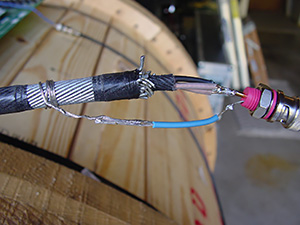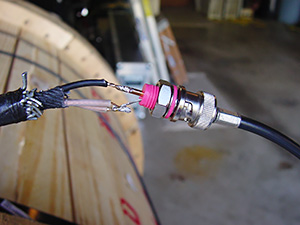DataMaxx™ from SONASEARCH
SONASEARCH Hi-speed DataMaxx™ technology provides 4x improvements in simultaneous, bi-directional e-line data rates. The following results were achieved over 7,888 feet of Rochester 3-H-314A e-line spooled on a 24” wide wooden spool with an inside winding diameter of 21” and an outside diameter of 35”.
Coaxial Mode

Maximum coaxial mode communication rates is achieved across the e-line when used as a coaxial cable with all three center conductors connected together and with the signal applied between these connectors and the cable armor. Data was sent simultaneously through the cable in each direction with the resultant data rates, power levels and noise margins measured as follows:
- Bit Rate: 656 kbaud
- SNR: 25.0 dB
- Loop Attenuation: 13.5 dB
- Xmt Power: 13.5 dBm
- Rcv Gain: 22 dB
- Data Mode Margin: 2.3 dB
Twisted Pair Mode

Maximum twisted pair data rates is achieved when two of the center conductors are used as a differential pair and the third center conductor and outer armor are left floating. Data was sent simultaneously through the cable in each direction with the resultant data rates, power levels and noise margins measured as follows:
- Bit Rate: 2320 kbaud (2.3 Mbaud)
- SNR: 33.9.0 dB
- Loop Attenuation: 12.3 dB
- Xmt Power: 13.5 dBm
- Rcv Gain: 18.89 dB
- Data Mode Margin: 11.29 dB
Notes:
- Loop attenuation indicates path loss. This number will increase as the cable length increases.
- SNR indicates signal to noise ratio. Larger values are better. Communication is possible with SNRs above about 22 dB.
- Data Mode Margin is roughly the difference between the current signal to noise ratio and the minimum signal to noise ratio necessary for data communications. Margins below 0 dB will result in unacceptable bit error rates.
- Xmt Power indicates the line driver power setting.
- Rcv Gain indicates the receiver gain setting. As the Loop attenuation figure goes up, transmit power and receiver gain are adjusted up to compensate for this signal loss.

